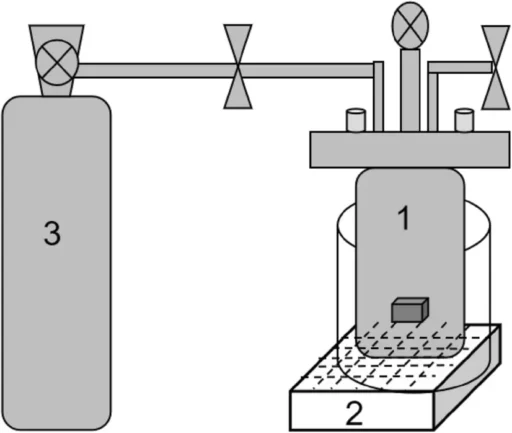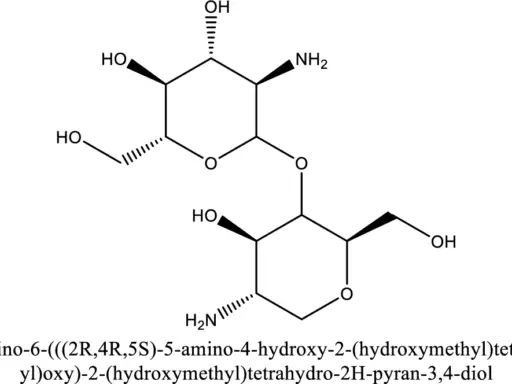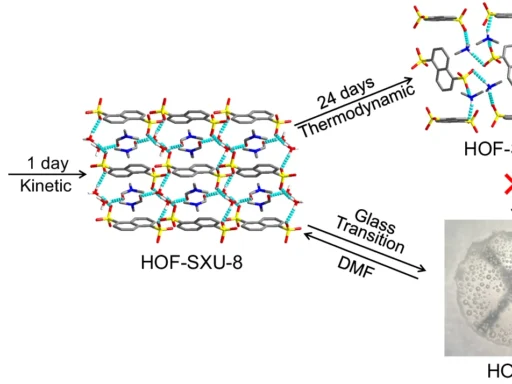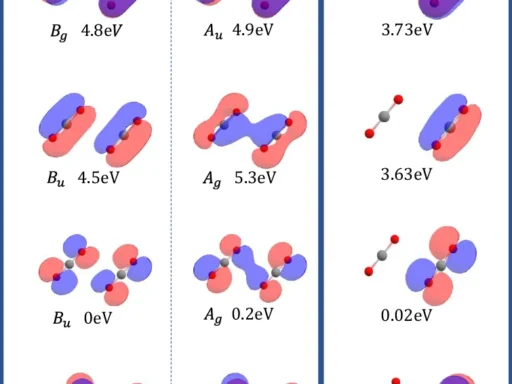Table of Contents
Researchers now recognize ultrasonic pretreatment as a crucial method for extracting bioactive chemicals from plant materials. This study investigates the enhancement of ultrasonic pretreatment, specifically for determining chlorogenic acid in potato leaves.
An Overview of Ultrasonic Pretreatment:
Ultrasonic pretreatment utilizes high-frequency sound waves to break cell structures and improve the desired chemical extraction from plants. Ultrasonic waves induce the formation of cavitation bubbles, which subsequently collapse, releasing high levels of heat and pressure. This phenomenon aids in cell wall disintegration and improves mass transfer efficiency.
In comparison to traditional approaches, the use of ultrasonic pretreatment has become increasingly popular because of its efficacy in enhancing extraction yields and decreasing processing time. This technology has diverse uses in industries such as medicine, food, and cosmetics.
Chlorogenic acid serves a function in potato leaves:
Chlorogenic acid is a significant polyphenolic chemical that is present in a variety of plants, including potato leaves. It belongs to the hydroxycinnamic acid family and is known for its antioxidant properties. Chlorogenic acid has shown promise in promoting health by exhibiting anti-inflammatory, anti-diabetic, and cardiovascular protective properties.
Chlorogenic acid in potato leaves aids in the plant’s defense against environmental stresses. It functions as a phytochemical barrier, safeguarding the plant against diseases and UV radiation.
Self-designed device for the extraction of chlorogenic acid in potato leaf powders. Part 1: sealed chamber; Part 2: a device set heat and ultrasonic; Part 3: the compressed gas cylinder of N2.

Molecular theoretical calculation diagram of chlorogenic acid: (a) stick model diagram; (b) HOMO; (c) LUMO.
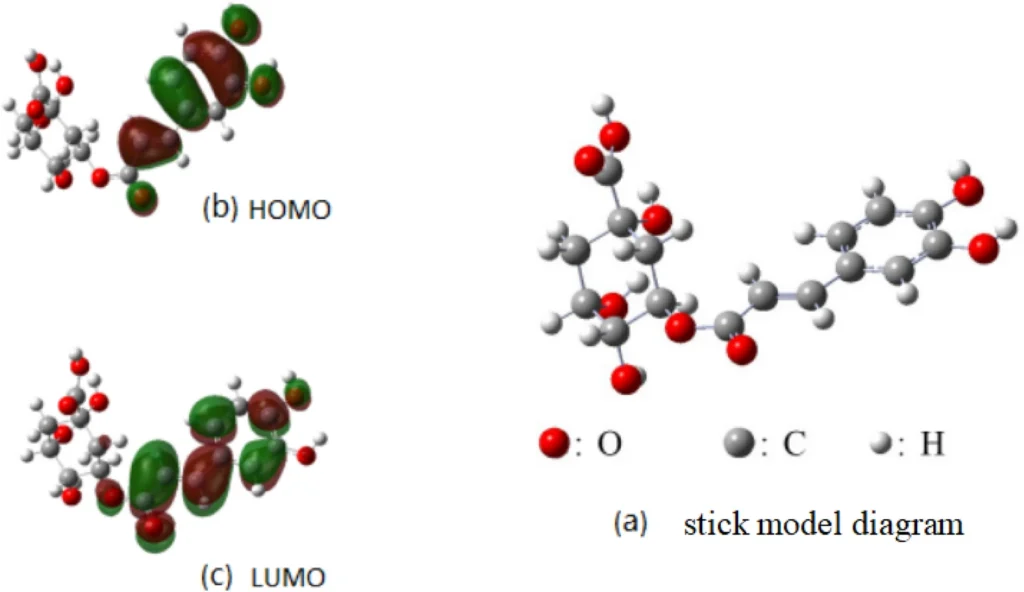
Methods for enhancing the efficiency of ultrasonic extraction:
To optimize chlorogenic acid extraction efficiency from potato leaves, certain important parameters must be optimized:
Variables Impacting Extraction Efficiency:
1). Frequency: Ultrasonic wave frequency has a direct impact on the creation and collapse of cavitation bubbles, which in turn affects cell disruption.
2). Power Intensity: Increasing the power intensity can improve the extraction efficiency, but it is important to find the optimal level to prevent thermal damage.
3). Extraction Time: The amount of compound released while maintaining the desired quality depends on the duration of the ultrasonic treatment.
4). Solvent Type: The type of solvent selected has an impact on chlorogenic acid’s solubility and selectivity.
To achieve the desired extraction yield and quality, experimental design and statistical analysis are required to optimize these parameters.
Techniques for Analyzing Chlorogenic Acid:
Using a variety of analytical techniques, such as the following, we determine the amount of chlorogenic acid after the extraction process:
Standard analytical methods:
1). High-Performance Liquid Chromatography (HPLC): High-Performance Liquid Chromatography (HPLC) is the preferred technique for quantifying chlorogenic acid because of its exceptional sensitivity and specificity.
2). UV-Vis Spectrophotometry: UV-Vis spectrophotometry is a technique for quantifying chlorogenic acid content by measuring absorbance at specific wavelengths.
3). Mass Spectrometry (MS): Mass spectrometry (MS) is a technique that offers precise data on the molecular weight of substances and can verify the presence of chlorogenic acid in complicated mixes.
Precise measurement of chlorogenic acid is crucial for ensuring quality control and evaluating the effectiveness of plant extracts in various applications. IR spectrum of chlorogenic acid: (a) fitting of Gauss03; (b) extraction.

UV spectrum (a) and fluorescence spectrum (b) of chlorogenic acid: curve 1 is chlorogenic acid standard; curve 2 is extraction.
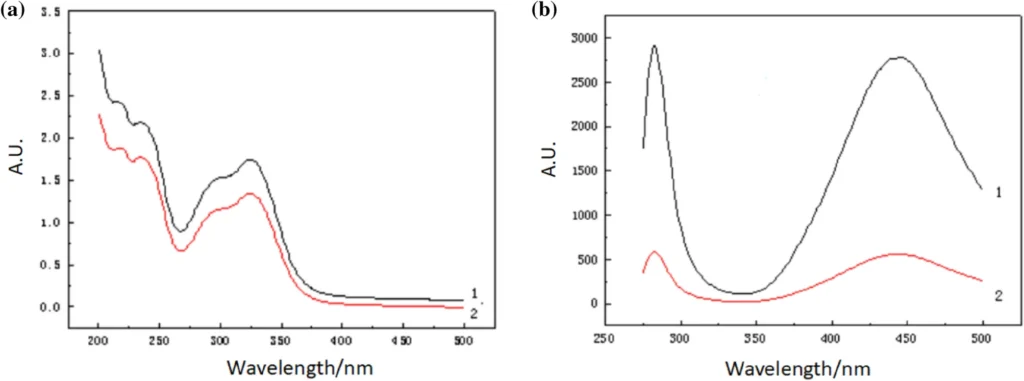
Scientific studies on the foliage of potatoes are underway:
Several research papers have examined the phytochemical makeup of potato leaves and explored their possible uses:
Overview of Pertinent Research Discoveries:
1). Antioxidant Activity: Chlorogenic acid and other polyphenols in potato leaves contribute to their notable antioxidant activity.
2). Anti-Inflammatory Effects: Chlorogenic acid exhibits anti-inflammatory effects, which can be advantageous for illnesses such as arthritis and inflammatory skin disorders.
3). Antimicrobial Activity: Potato leaf extracts exhibit significant antibacterial action against harmful bacteria and fungi.
The findings emphasize the diverse potential of potato leaves as a valuable source of bioactive chemicals for the pharmaceutical and nutraceutical industries.
Several research papers have examined the phytochemical makeup of potato leaves and explored their possible uses:
Overview of Pertinent Research Discoveries:
1). Antioxidant Activity: Chlorogenic acid and other polyphenols in potato leaves contribute to their notable antioxidant activity.
2). Anti-Inflammatory Effects: Chlorogenic acid exhibits anti-inflammatory effects, which can be advantageous for illnesses such as arthritis and inflammatory skin disorders.
3). Antimicrobial Activity: Potato leaf extracts exhibit significant antibacterial action against harmful bacteria and fungi.
The findings emphasize the diverse potential of potato leaves as a valuable source of bioactive chemicals for the pharmaceutical and nutraceutical industries.
Several research papers have examined the phytochemical makeup of potato leaves and explored their possible uses:
Overview of Pertinent Research Discoveries:
1). Antioxidant Activity: Chlorogenic acid and other polyphenols in potato leaves contribute to their notable antioxidant activity.
2). Anti-Inflammatory Effects: Chlorogenic acid exhibits anti-inflammatory effects, which can be advantageous for illnesses such as arthritis and inflammatory skin disorders.
3). Antimicrobial Activity: Potato leaf extracts exhibit significant antibacterial action against harmful bacteria and fungi.
The findings emphasize the diverse potential of potato leaves as a valuable source of bioactive chemicals for the pharmaceutical and nutraceutical industries. HPLC of chlorogenic acid 1: chlorogenic acid standard; 2: potato leaf extraction.

Advantages of Ultrasonic Pretreatment:
Ultrasonic pretreatment has numerous benefits compared to conventional extraction methods:
Benefits Compared to Conventional Approaches:
1). Increased Extraction Efficiency: Ultrasonic waves enhance the transfer of mass, resulting in larger yields during extraction.
2). Decreased Processing Time: Shorter extraction cycles result in time and energy savings.
3). Selective Extraction: Ultrasonic waves have the ability to precisely target specific molecules, reducing the amount of solvent required.
4). Environmentally Friendly: Ultrasonic extraction is environmentally friendly and reduces the need for aggressive chemicals, promoting sustainability.
Ultrasonic pretreatment is a highly appealing choice for commercial extraction procedures due to its environmentally favorable characteristics and flexibility in size adjustment.
Obstacles and Constraints:
While ultrasonic pretreatment is advantageous, it also has several drawbacks and limitations:
Challenges Faced in Extraction and Analysis:
1). Heat Degradation: Long-term exposure of heat-sensitive materials to ultrasonic vibrations can cause thermal deterioration.
2). Equipment Cost: High-power ultrasonic equipment may require a significant financial commitment.
3). Optimization Complexity: Adjusting extraction settings with precision can be a time-consuming task that necessitates specialized expertise.
4). Scalability: Increasing the capacity of ultrasonic extraction for industrial production may pose engineering challenges.
To overcome these hurdles, it is necessary to employ creative strategies in equipment design, process optimization, and analytical procedures.
The future holds emerging patterns and advancements:
Ongoing research and technological breakthroughs are shaping the future of ultrasonic pretreatment and chlorogenic acid analysis.
The future holds emerging patterns and advancements:
1). Combined Techniques: We are utilizing ultrasonic pretreatment in conjunction with other technologies, such as microwave-assisted extraction, to improve efficiency.
2). Nanotechnology Use cases: Nanoemulsions and nanoparticles have the potential to improve chlorogenic acid transport and absorption, thereby improving administration and bioavailability.
3). Automation and Robotics: Automated systems and machines, often using advanced technology and programming, perform tasks without human intervention. Automated extraction systems optimize procedures and guarantee consistency.
4). Machine Learning and Data Analytics: We use predictive modeling and data-driven approaches to optimize the extraction parameters for specific plant materials.
The ongoing advancement in extraction and analysis techniques will drive the growth of new goods and applications in the bioactive chemical sector.
In conclusion:
Finally, ultrasonic pretreatment optimization is critical for efficient chlorogenic acid extraction from potato leaves. This method provides a multitude of advantages, such as enhanced extraction efficiency, decreased processing time, and environmentally friendly operations. Nevertheless, continuous advancement in research and innovation is necessary to overcome obstacles, including heat deterioration and equipment expenses. The future of ultrasonic pretreatment lies in the integration of new technologies to boost extraction and analytical capabilities.
FAQs:
1. What is the definition of chlorogenic acid?
Chlorogenic acid is an inherent polyphenol present in plants, recognized for its antioxidant characteristics and advantageous effects on health.
2. What is the mechanism by which ultrasonic pretreatment improves extraction efficiency?
Ultrasonic waves disrupt cell architecture, allowing bioactive chemicals such as chlorogenic acid to be liberated from plant material.
3. What are the Applicstions of Chlorogenic acid?
The pharmaceutical, nutraceutical, and cosmetic industries utilize chlorogenic acid due to its diverse health-enhancing qualities.
4. What are the challenges of ultrasonic extraction? The challenges of ultrasonic extraction include a multitude of difficulties and obstacles that arise during the process.
The possibility of heat degradation of compounds and the initial costs associated with equipment are among the challenges.
5. How can we improve the efficiency of extracting chlorogenic acid from potato leaves?
Maximize efficiency by optimizing extraction parameters, such as ultrasonic frequency, power intensity, and extraction time.
For more chemistry blogs, visit chemistry Master

